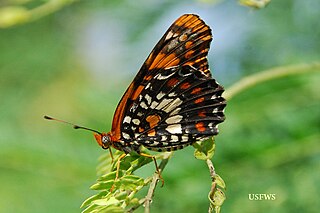
Mimosa is a genus of about 600 species of herbs and shrubs, in the mimosoid clade of the legume family Fabaceae. Species are native to the Americas, from North Dakota to northern Argentina, and to eastern Africa as well as the Indian subcontinent and Indochina. The generic name is derived from the Greek word μῖμος (mimos), an "actor" or "mime", and the feminine suffix -osa, "resembling", suggesting its 'sensitive leaves' which seem to 'mimic conscious life'.

Albizia julibrissin, the Persian silk tree, pink silk tree, or mimosa tree, is a species of tree in the Fabaceae family, native to southwestern and eastern Asia.

Acacia, commonly known as wattles or acacias, is a genus of about 1,084 species of shrubs and trees in the subfamily Mimosoideae of the pea family Fabaceae. Initially, it comprised a group of plant species native to Africa, South America, and Australasia, but is now reserved for species mainly from Australia, with others from New Guinea, Southeast Asia, and the Indian Ocean. The genus name is Neo-Latin, borrowed from the Greek ἀκακία, a term used in antiquity to describe a preparation extracted from Vachellia nilotica, the original type species.

Leucaena leucocephala is a small fast-growing mimosoid tree native to southern Mexico and northern Central America and is now naturalized throughout the tropics including parts of Asia.

Leucaena is a genus of flowering plants in the mimosoid clade of the subfamily Caesalpinioideae of the family Fabaceae. It contains about 24 species of trees and shrubs, which are commonly known as leadtrees. They are native to the Americas, ranging from Texas in the United States south to Peru. The generic name is derived from the Greek word λευκός (leukos), meaning "white," referring to the flowers.

Mimosine or leucenol is a toxic non-protein amino acid chemically similar to tyrosine. It occurs in some Mimosa spp. and all members of the closely related genus Leucaena.

Albizia lebbeck is a species of plant in the family Fabaceae, native to the Indian subcontinent and Myanmar. It is widely cultivated and naturalised in other tropical and subtropical regions, including Australia. Common names in English include siris, Indian siris, East Indian walnut, Broome raintree, lebbeck, lebbek tree, frywood, koko and woman's tongue tree. The latter name is a play on the sound the seeds make as they rattle inside the pods. Siris is also a common name of the genus Albizia.

Ministrymon is a genus of butterflies in the family Lycaenidae. The species of this genus are found in the Nearctic and Neotropical realms.

Pyloetis is a moth genus, belonging to the family Tineidae. It consists of only one species, Pyloetis mimosae, which is found in Asia, including Japan and Taiwan.

Scotorythra paludicola, the koa looper moth, is a moth of the family Geometridae. It was first described by Arthur Gardiner Butler in 1879. It is endemic to the Hawaiian islands of Kauai, Oahu, Maui and Hawaii.

Pyrisitia nise, the mimosa yellow, is a butterfly in the family Pieridae. It is found from Argentina north to the Texas Gulf Coast and throughout central and southern Florida, northward to the Tennessee Valley. It is an occasional stray to central Texas and south-eastern Arizona and rarely to southern California, southern Colorado and Kansas. The habitat consists of brushy woodland edges.

Eurema floricola, the Malagasy grass yellow, is a butterfly in the family Pieridae. It is found in Sierra Leone, Ivory Coast, Ghana, Nigeria, the Democratic Republic of Congo, Burundi, Kenya, Tanzania, Zambia and on Madagascar, the Comoros, Mauritius, Réunion and the Seychelles. Its habitat consists of the forest/savanna transition zone.

Cigaritis victoriae, the Victoria's bar or Victoria silverline, is a butterfly in the family Lycaenidae. It is found in southern and eastern Kenya, Tanzania, Malawi, Mozambique and eastern Zimbabwe. The habitat consists of savanna.

Atlantea tulita is a rare species of butterfly known by the common name Puerto Rico harlequin butterfly. This brush-footed butterfly is endemic to Puerto Rico. It is a candidate for United States federal protection as an endangered species. In 2011 a report found federal protection to be warranted, but it was precluded by other actions and it remains a candidate.

Ministrymon janevicroy, the Vicroy's ministreak, is a butterfly in the family Lycaenidae. It is found from the southern United States (Texas) to Costa Rica (Guanacaste). There are disjunct populations on the Venezuelan islands of Curaçao and Isla Margarita. The habitat consists of dry deciduous forests and scrubs.

Acanthoscelides is a genus of bean weevils of the subfamily Bruchinae. They are native to the New World. About one third of them can be found in Mexico.
Mesophleps adustipennis, the soybean webworm moth, is a moth of the family Gelechiidae. It is found in the western and southern parts of the United States, Mexico, Honduras, Costa Rica, Panama, Cuba, the West Indies, Venezuela, Ecuador, Peru, Brazil.
Ithome lassula is a moth in the family Cosmopterigidae. It was described by Ronald W. Hodges in 1962. It is found in North America, where it has been recorded from Florida. It was introduced into Australia by accident, where it is now found in Queensland.
Heteropsylla cubana, the leucaena psyllid, is a species of in the family Psyllidae. It is native to South and Central America and can cause harm to species of broadleaved trees, such as Albizia, Mimosa, Leucaena leucocephala and Samanea saman. It has also been found in Asia, on the islands of the South Pacific and in Africa. The insect feeds on the young leaves and shoots, and on the older parts, also the flowers. The twig tops die off, and in serious cases the whole tree can die after dropping all leaves.

Oncideres pustulata is a species of beetle in the family Cerambycidae. It was described by John Lawrence LeConte in 1854. It is known from Mexico and the United States. It feeds on Leucaena leucocephala, Leucaena pulverulenta, Prosopis alba, and Prosopis chilensis.

















